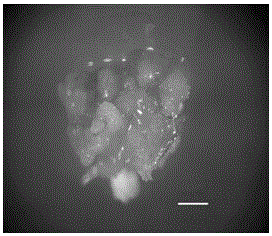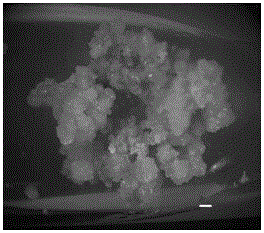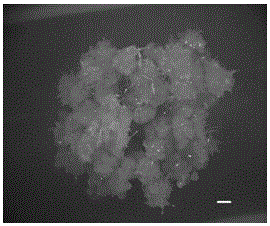Establishment method of efficient regeneration system of mniochloa abersend
A technology for high-efficiency regeneration and establishment of methods, applied in the field of plant tissue culture, can solve problems such as difficult observation of offspring phenotypes, unpredictable flowering time, and distant kinship of bamboo, and achieve simple and easy implementation steps, loose implementation conditions, and excellent results. significant effect
- Summary
- Abstract
- Description
- Claims
- Application Information
AI Technical Summary
Problems solved by technology
Method used
Image
Examples
Embodiment
[0034] The establishment method of moss bamboo efficient regeneration system is characterized in that it is carried out according to the following steps:
[0035] 1) Callus induction culture
[0036] Select the buds from the vigorous growth and no disease-spotted bamboo plants in the greenhouse as explants, cut off the 1.5-2.5cm stem section with buds, rinse with tap water for 1-2h, soak in 75% alcohol for 30s, and then use the mass ratio Vacuum filtration disinfection of 1% sodium hypochlorite solution for 15 minutes, rinse 5-6 times with sterile water in an ultra-clean workbench, and finally peel off the leaf sheath under a stereo microscope, cut out 0.4-0.6 cm of bud stems, one for each tube The buds were inoculated in the induction medium: the basic induction medium was MS (Murashige and Skoog), and the added exogenous hormone was 1-5mg L -1 2,4-D is 2,4-dichlorophenoxyacetic acid and 1-2mg·L -1 NAA is naphthaleneacetic acid, adjust the pH to 5.75.7; the culture conditio...
experiment example
[0046] The test relevant to the present invention and accompanying drawing will be introduced below:
[0047] Figure 1-Figure 8 , the regeneration process can be understood from the accompanying drawings and in conjunction with the corresponding descriptions, and no further introduction is made.
[0048] Figure 9 It is a comparison chart of callus and compact good callus induction of moss bamboo shoots in the following five different basic media (MS, 1 / 2MS, WPM, N6, B5) (for details of various basic media formulations, see: Wang Di , Plant Tissue Culture, Beijing: China Agricultural Press, 2004). About two weeks after the buds were inoculated on the culture medium, the buds began to expand, and calluses appeared at the bud tips around four weeks, and the callus grew well after fifty days. It can be seen from the figure that the induction rates of MS, 1 / 2MS, and WPM were not significantly different, being 75.55%, 77.78%, and 80%, respectively, but they were significantly d...
PUM
 Login to View More
Login to View More Abstract
Description
Claims
Application Information
 Login to View More
Login to View More - R&D
- Intellectual Property
- Life Sciences
- Materials
- Tech Scout
- Unparalleled Data Quality
- Higher Quality Content
- 60% Fewer Hallucinations
Browse by: Latest US Patents, China's latest patents, Technical Efficacy Thesaurus, Application Domain, Technology Topic, Popular Technical Reports.
© 2025 PatSnap. All rights reserved.Legal|Privacy policy|Modern Slavery Act Transparency Statement|Sitemap|About US| Contact US: help@patsnap.com



